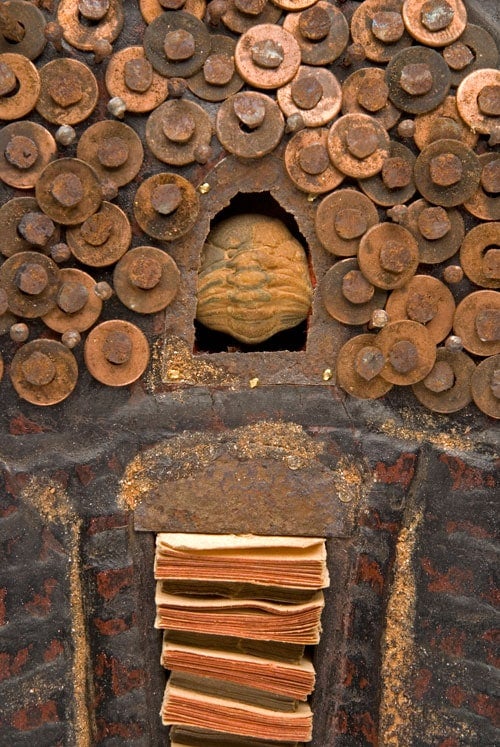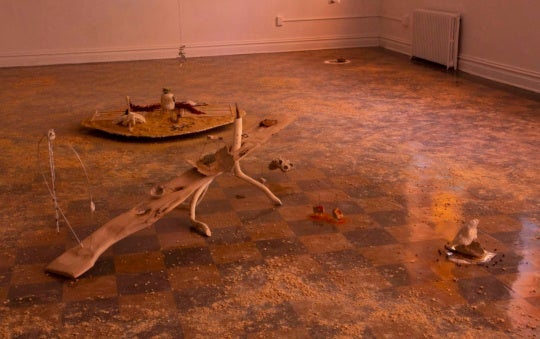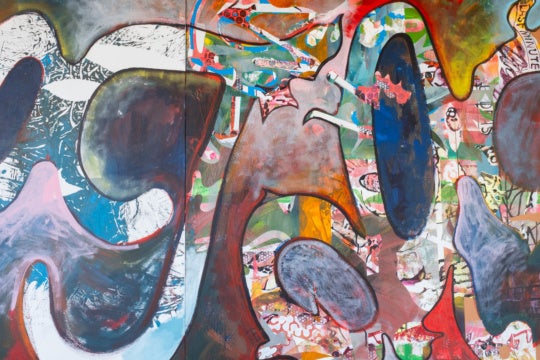
The healing power of art was demonstrated in the aftermath of the shootings at Mother Emanuel AME church on June 17, 2015, in Charleston. Groups of artists across the Lowcountry came together for exhibitions to raise money for the victim’s families, murals were painted, and mandala workshops were conducted. Charleston’s Gibbes Museum of Art [disclosure: I was marketing manager at the Gibbes until September 2015] was undergoing renovations during this time and was scheduled to reopen the following year. Curator Pam Wall planned an exhibition of contemporary Southern artists that would address the complicated history of the South and offer the community a space for conversation and healing. That show is currently on view at the Gibbes through October 9.
Titled “The Things We Carry: Contemporary Art in the South,” the exhibition includes past finalists and winners of the Gibbes’s 1858 Prize for Contemporary Southern Art, an annual prize that awards $10,000 to an artist whose work contributes to a new understanding of art in the South. The diverse group of artists includes Bo Bartlett, William Christenberry, Sonya Clark, Andrea Keys Connell, Lonnie Holley, Deborah Luster, Sally Mann, Stephen Marc, Mike Smith, Damian Stamer, and Stacy Lynn Waddell.

Self-taught artist and musician Lonnie Holley created the sculpture Changing Power (2014) with objects that came from Mother Emanuel Church. In 2014, Holley visited Charleston while planning for his 2015 exhibition at the Halsey Institute of Contemporary Art and scavenged materials for his work. He collected discarded electrical wiring from the site of Emanuel AME Church and incorporated it into Changing Power. Featuring a lamp without a bulb and a tangle of tubing and wires, Wall explains that the piece represents the disruption that often accompanies change. “Although Changing Power was created before the church shooting, one cannot help but connect the sculpture, and its metaphorical moment of darkness, to the terrible tragedy.”
Andrea Keys Connell’s life-sized sculpture 2016 Monument depicts a soldier looming over a cowering child. Connell’s work transforms the concept of a monument from a hallowed, memorialized structure into something fierce and foreboding.

Sonya Clark, a fiber and mixed-media artist and the 2014 winner of the 1858 Prize, uses human hair, an unraveled Confederate flag, and an armchair transformed by human hair to address issues of African American identity and race. “Her work is a visual and tangible reminder of the labor that created the wealth and the collection of these decorative art objects,” says Wall. Dream Building Ensemble (2001) by William Christenberry comprises eleven white, narrow and pointed wooden sculptures that resemble skyscrapers against a dark blue wall. Christenberry grew up in Alabama and is known for his work that confronts the tragic history of the Ku Klux Klan. His haunting, dream buildings echo the white hoods of Klansmen.

School of the Americas (2010), a large-scale painting by Bo Bartlett, depicts four young women participating in a “die-in” protest where participants pretend to be dead. The arresting image was inspired by protests at Fort Benning in Georgia, near Bartlett’s childhood home, and is at first glance a beautiful composition, until the viewer steps closer to see small cuts on the girl’s bodies and pools of blood. In contrast, Damian Stamer’s abstracted paintings feature landscapes of North Carolina “that would rather be left alone.” His oil-on-wood panel painting South Lowell (2014) depicts an abandoned barn or shed as the only recognizable object in an otherwise abstracted surface of expressive brushstrokes that seem to be erasing or transforming the remnants of memories of of a past place and time.
The work of Deborah Luster, who won last year’s 1858 Prize, is represented by a series of tondo (round) photographs titled Tooth for an Eye: A Chorography of Violence in Orleans Parish (2008-10), which explores themes of death and loss in her home state of Louisiana. Each black-and-white photograph depicts a different site where a murder took place in New Orleans. A large table displays ledgers that visitors can flip through and read each victim’s name, age, and cause of death.

Sally Mann’s Deep South (1951) series of large-format photographs depict imposing plantations in states of disrepair and ruin. Her haunting images, created with nineteenth-century photography technique and glass plate negatives, convey the emotional weight of history. A photo from Stephen Marc’s series Passage on the Underground Railroad (2002) belongs to the museum’s permanent collection and was informed by the artist’s travels throughout the country researching the Underground Railroad. The image features a young black man with fraternity letters branded on his arm, combining potent visual elements of the past and present.
Wall says, “For me, the most gratifying aspect of the exhibition has been the amount of time visitors have spent in the gallery. They are taking the time to really look. They are asking questions. They are discussing works with their friends. Hopefully this leads to meaningful conversations about racism and violence in America, and how we move forward as a society.” She points out the remarks visitors are leaving in the museum’s comment book, especially one that reads: “Sonya Clark’s abacus with human hair made me want to weep. This is what art is supposed to do. Move us.”
Amy Mercer is a writer living in Charleston, South Carolina.




